Salmon bites is an easy 5-ingredient, 10-minute recipe, featuring cubed salmon marinated in a simple honey sesame soy sauce and pan-seared to crispy perfection! Since marinating is optional, you can whip this up at a moment’s notice, and you’ll want to put the marinade on everything.
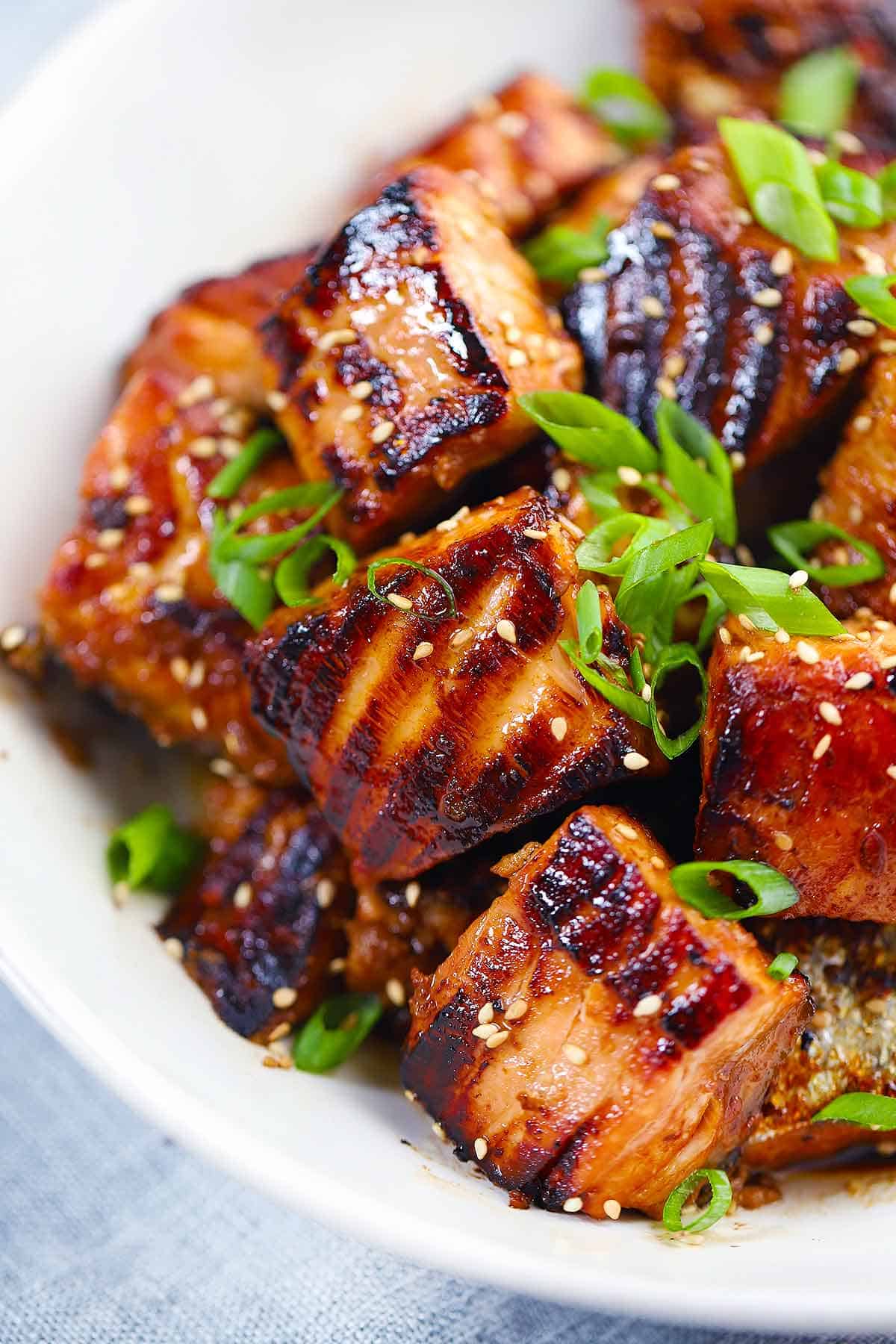
Salmon is one of my favorite proteins to cook. It’s loaded with nutrition, including good-for-you omega 3s and Vitamin D, and it’s easily accessible at any grocery store.
It’s not super expensive, but it’s not super cheap either. So I love cubing the salmon into bite-size pieces to make salmon bites. Somehow, cooking smaller pieces seems to make it go further.
Maybe it’s because each little salmon nugget is so satisfying, wrapped in tons of flavor from the sauce and seared to crispy perfection. It also means you can buy any kind that’s cheap, because you don’t need huge beautiful thick fillets for this, which are usually more expensive.
The marinade is the same that I use for searing ahi tuna – a simple mixture of soy sauce, toasted sesame oil, and honey.
These salmon bites are perfect served in a salmon bowl, with cooked rice and some sautéed veggies. I like throwing the veggies right in the same skillet in which I cooked the salmon for maximum flavor.
Ingredients and Substitutions
- Salmon – any kind (wild, farmed, sockeye, etc.)
- Soy sauce – or gluten-free (tamari), or coconut aminos, if needed.
- Toasted Sesame Oil – you can find this in the Asian section of your grocery store.
- Honey – or another sweetener like maple syrup or brown sugar (can be omitted)
- Canola oil – or other neutral tasting oil, for searing
- Optional ingredients: sriracha or other hot sauce, green onions, and sesame seeds for garnish
How to make Pan-Seared Salmon Bites
- First, cube the salmon. Mix up the sauce – soy sauce, toasted sesame oil, and honey (and sriracha if you want), and pour the sauce over the salmon. Toss to coat.
- Optional: at this point you can marinate for 30 minutes – 6 hours in the fridge, tossing occasionally to redistribute sauce. This will enhance the flavor but if you don’t have time to marinate, you can just proceed with the recipe.
- Heat a large skillet and add the canola oil. Remove salmon pieces to skillet using tongs so the sauce stays in the bowl. Sear the salmon skin-side down (if it has skin on it) for 2-3 minutes, then flip and sear on the other side for 2-3 minutes, or until it’s fully cooked.
- Pour the remaining sauce in the skillet and toss gently to coat the salmon.
- Serve garnished with green onion and sesame seeds.
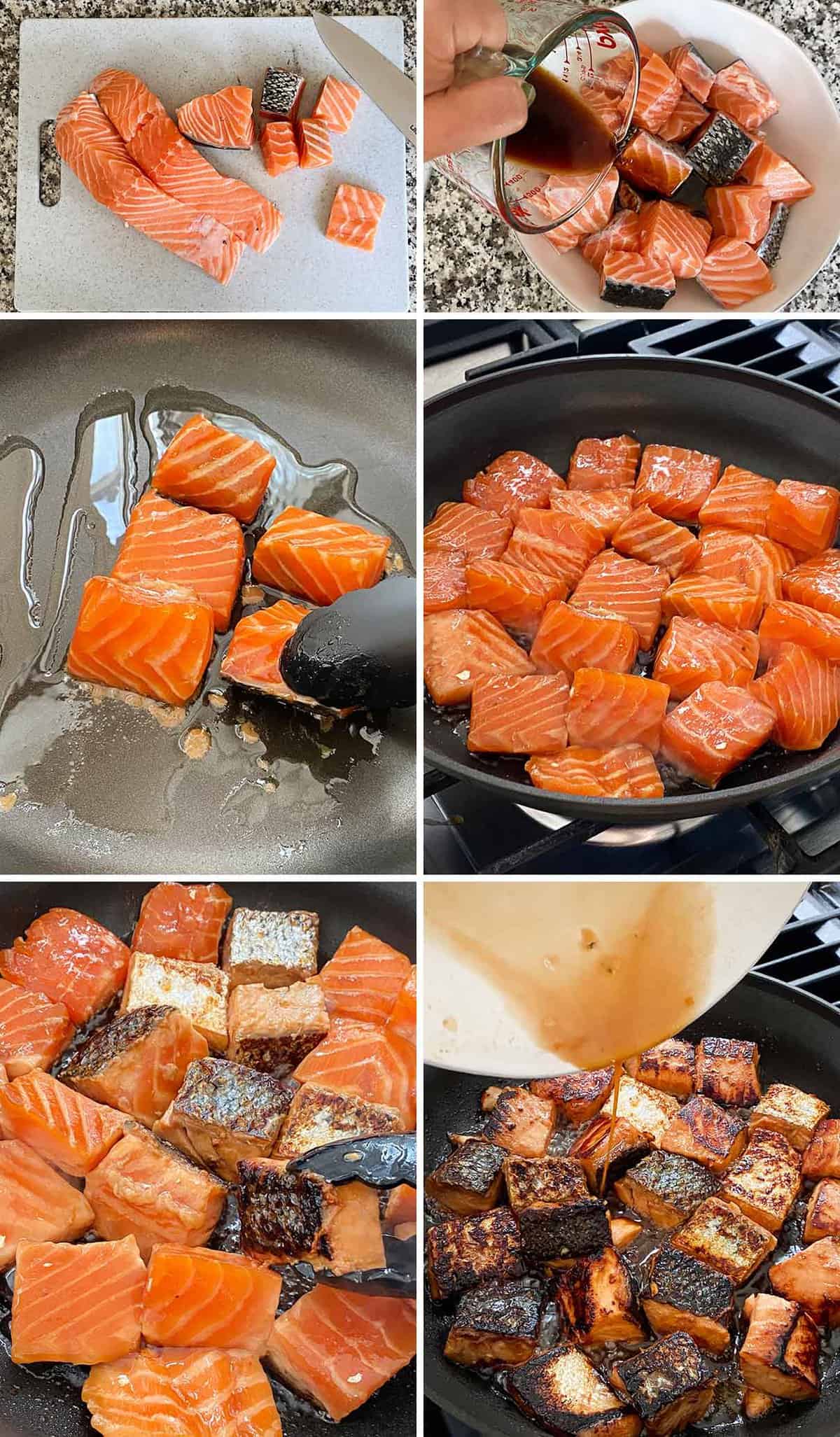
Salmon Bites FAQs
I personally LOVE eating salmon skin when it’s crispy from pan-frying! I leave the skin ON for this recipe, and I make sure to sear the skin side when cooking. Crispy salmon skin is delicious and loaded with nutrition. That said, it’s completely up to you if you want to eat it or not. You can ask your fishmonger to remove the skin when you buy fresh salmon, if you like.
I like serving salmon bites with cooked rice and veggies. I usually cook rice myself (I love basmati because it’s one of the fastest cooking rices), but this is a great opportunity to use pre-cooked rice for a fast and easy meal. Just throw the veggies right in the skillet I cooked the salmon in for maximum flavor (see tips and tricks below).
There are a lot of types of salmon out there – wild, farm-raised, sockeye, etc. For this recipe, you can use any kind you want. I personally love the taste and texture of farm-raised salmon, though wild is a bit healthier. If you’re on a budget, this is a great opportunity to get the least expensive one, since you don’t need full, thick filets for this recipe – small pieces are often cheaper!
This recipe should be made with fully defrosted salmon if previously frozen, to ensure it cooks evenly and completely. Unwrap the frozen salmon and place on a plate or shallow bowl. Put in your refrigerator for about 24 hours. It should be defrosted by then, depending on how thick it is. It might need a bit longer.
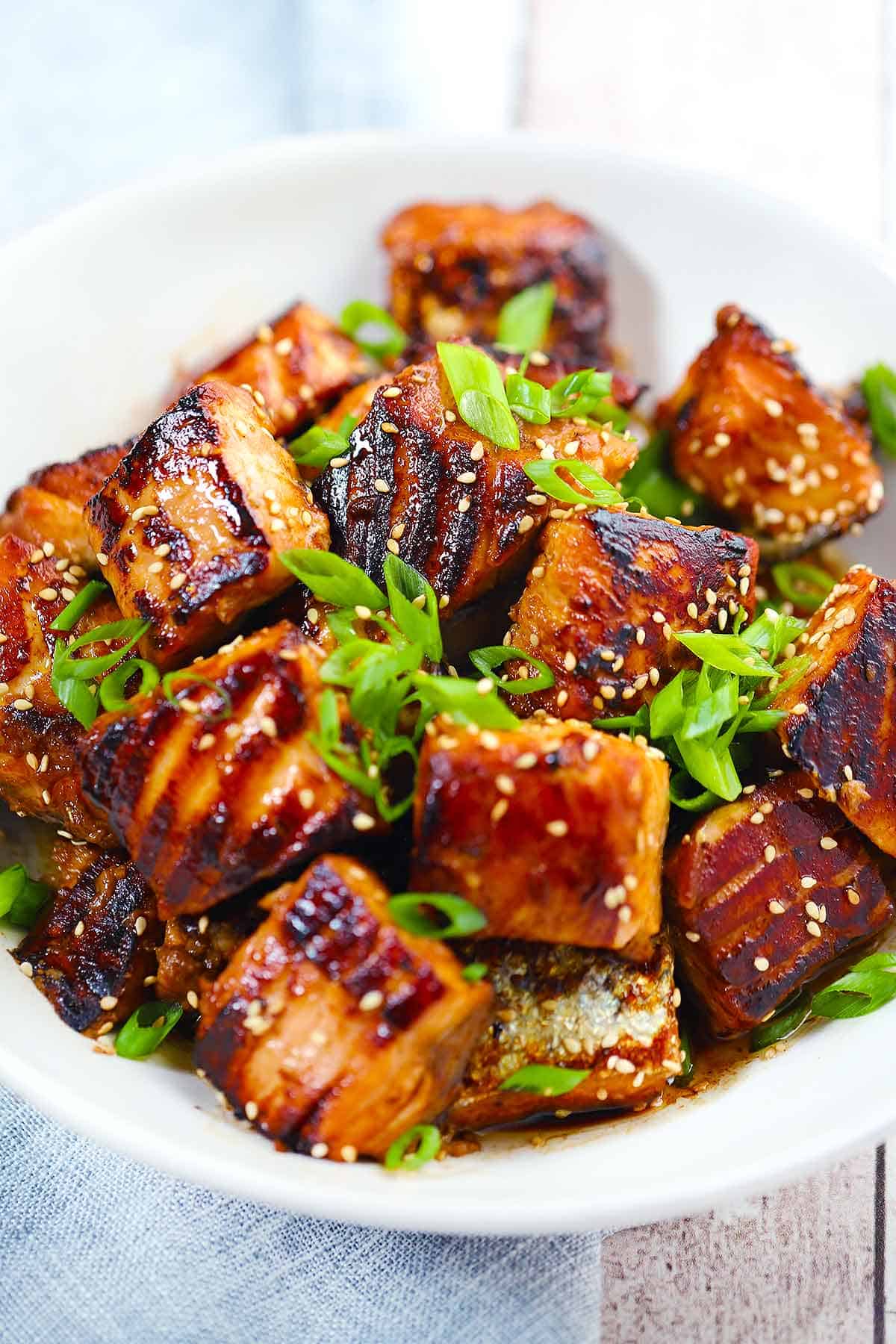
Tips and Tricks
- Be sure to sear the salmon well, on at least two sides until it’s nice and browned. This not only adds a ton of flavor, but creating that sear also helps the salmon hold together well. Salmon is a fish that flakes apart easily, and that sear helps tighten up the surface so it holds its shape well.
- Make sure the salmon bites are in a single layer in the skillet. The more crowded the skillet is, the harder it will be to get a good sear. Do two batches if necessary.
- Cook veggies in the same skillet as the salmon. If serving these salmon bites with vegetables, I recommend throwing prepped veggies right in the skillet (without washing it – you want that flavor!) after cooking the salmon. The remaining sauce leftover will help flavor the veggies and there will likely already be enough oil left in the pan.
- You’ll need the skillet to be very hot to get a good sear. But if it seems to be browning too quickly and the salmon isn’t fully cooked, turn the heat down.
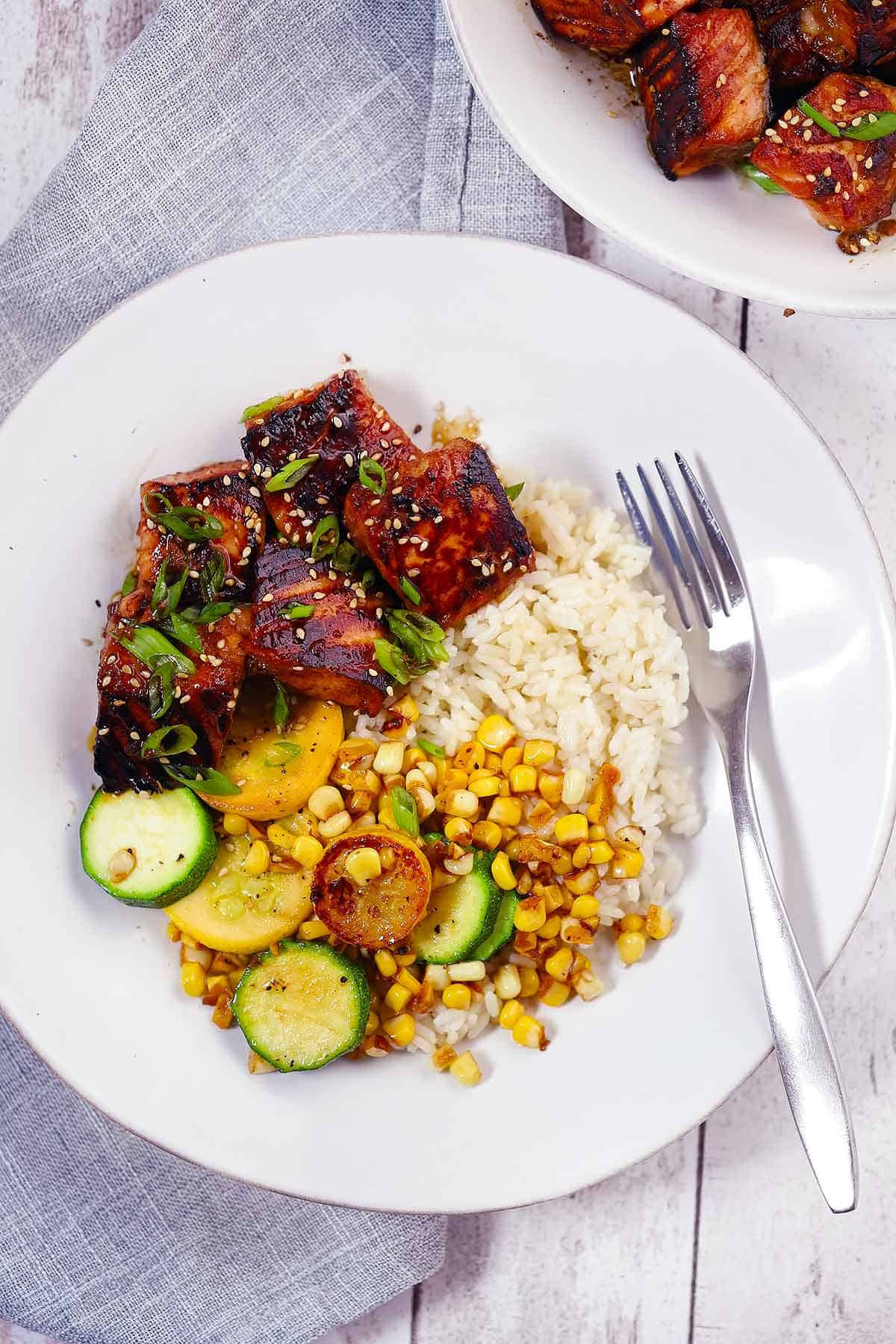
Other easy salmon recipes
- Chipotle Salmon Tacos
- Garlic Butter Sheet Pan Salmon and Veggies
- Poached Salmon with Chive Butter
- Oven BBQ Salmon
- Salmon, Arugula, and Feta Frittata
Did you know commenting and rating recipes is one of the best ways you can support your favorite food bloggers? If you made this recipe or have a question, please click the stars below to comment and Rate this Recipe and/or share photos on social media using the hashtag #bowlofdelicious or tagging @bowlofdelicious!
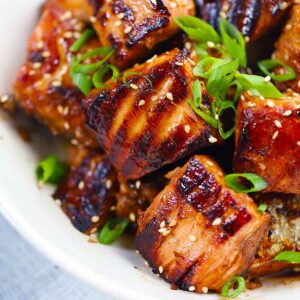
Pan-Seared Salmon Bites with Honey Sesame Soy Sauce
Equipment
- Large Skillet nonstick or cast iron is best
- Tongs
Ingredients
- 1.5 – 2 lbs. salmon cut into 1" cubes
- 1 tablespoon toasted sesame oil
- 2 tablespoons soy sauce
- 1 tablespoon honey
- 1 tablespoon canola oil
- 2 teaspoons sriracha or chili garlic sauce (optional, for a spicy version, more or less according to preference)
- green onions and sesame seeds for garnish (optional)
Instructions
- Place the cubed salmon into a shallow bowl or glass container. Mix together the soy sauce (2 tablespoons), toasted sesame oil (1 tablespoon), honey (1 tablespoon), and sriracha, if using (1-2 teaspoons) in a small bowl or glass measuring cup. Pour over the salmon and toss to coat well. For best results, allow to marinate for 30 minutes or up to 6 hours in the fridge, or proceed immediately with cooking.
- Heat a large skillet over medium-high heat until very hot. A nonstick or stainless steel skillet will only take 30 seconds to a minute to heat, whereas a heavy skillet like cast iron may take a few minutes.
- Add the canola oil (1 tablespoon) to the skillet and swirl to coat. Use tongs to remove the salmon cubes from the bowl of marinade and add them to the skillet (skin side down, if it has skin) and sear for 2-3 minutes, or until nice and brown. You should have some marinade left in the bowl. Flip the salmon using tongs and sear on the other side for 2-3 minutes, or until browned on the other side and fully cooked (see notes).
- Pour any remaining marinade into the skillet and toss salmon to coat in the sauce.
- Serve, garnished with sliced green onions and sesame seeds, if desired.
Notes
- I used regular soy sauce. Use low sodium if desired, or gluten free soy sauce (tamari) or coconut aminos if needed. You may find that the salmon lacks salt if using any of these alternatives – you can season with added salt if you like.
- Toasted sesame oil can be found in the Asian food section of your grocery store.
- Honey may be substituted with brown sugar, maple syrup, or other sweetener of choice, or omitted if you prefer no added sugar.
- If using a nonstick skillet, you may be able to get by without using any canola oil for searing the salmon bites.
- I like to serve salmon bites with veggies sautéed in the same pan I cooked the salmon in and rice on the side.
- If the salmon seems to be cooking too fast and browning too deeply but the inside still isn’t cooked, just turn the heat down. You can also cover the skillet to keep the heat in to help cook the inside faster.
- According to the FDA, salmon is fully cooked when it has an internal temperature of 145 degrees F. However, I personally find 125 degrees is a much better silky, juicy texture. Wild salmon may yield best results with 120 degrees. Here’s a good article from Cook’s Illustrated about what the ideal temperature is. I use my Thermoworks Thermapen One for a super fast, accurate read.
Nutrition
Nutrition Information Disclaimer
The provided nutrition information is my best estimate and does not include any added sodium from seasoning to taste, any optional ingredients, and it does not take brands into account. I use an automatic API to calculate this information. Feel free to calculate it yourself using one of these tools:


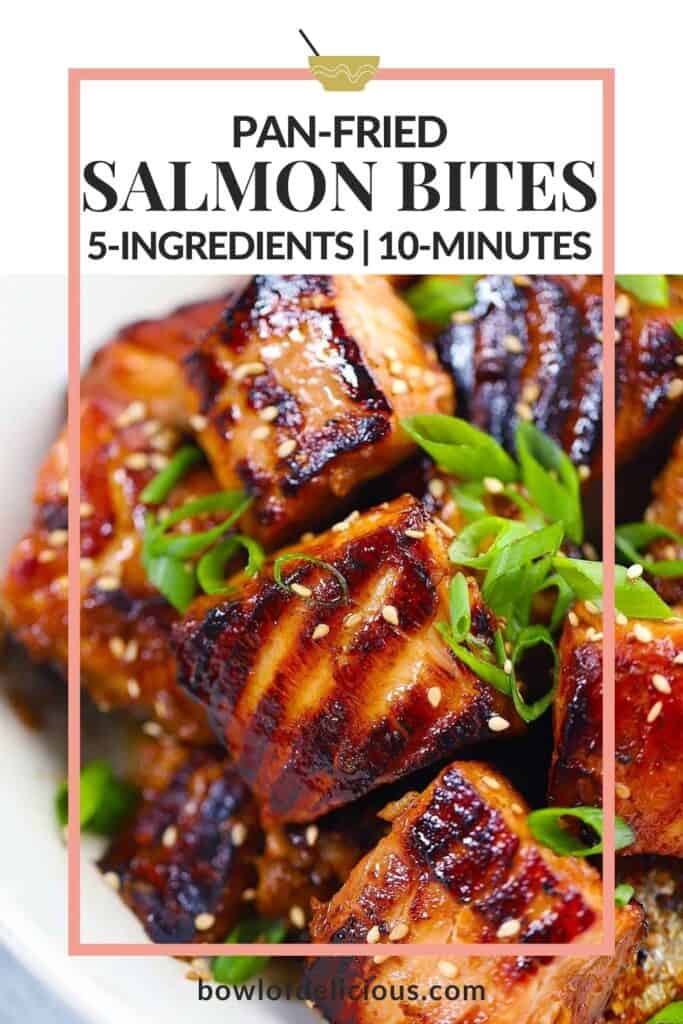
Jana Woodard
Thanks!!! Can’t wait to try this recipe!!!! Sounds delicious!!!!!
Elizabeth Lindemann
Hope you like it!
Richard Radamaker
I made this as an appetizer for our Christmas meal and even the young kids and picky eaters loved and raved about it. The one thing I did was just before serving I drizzled some store bought Yum Yum Sauce over it. Very Good!
Elizabeth Lindemann
So glad you liked it!
Dee
Can it marinate overnight or is that too much?
Elizabeth Lindemann
You can marinate it overnight if you want! The longer it marinates, the stronger the flavor – and with the soy sauce, the saltier it will taste. If you’re sensitive to salt and are planning on a long marinating time, you may want to take the amount of soy sauce down and then after you cook it, salt to taste if needed. Hope that helps!
Joyce Waite-Gibson
I’m Indonesian, so I add a little bit of chule flakes, garlic & ginger to the sauce. It was wonderful! Thank you so much for you recipe. I will definitely make this more often, DELISH!!
Elizabeth Lindemann
Thank you for sharing your additions, this sounds delicious! So glad you liked it!
Marilyn
A delicious recipe and it’s easy to prepare.
Elizabeth Lindemann
So glad you liked it!
Gary Z
I have made this twice now. I love to cook at home and this is a FANTASTIC and simple recipe. Soooo, tasty.
Elizabeth Lindemann
So glad you liked it!
Cindy
Very, very good. Next time I will make more sauce & add more hot seasonings. Will make again.
Elizabeth Lindemann
So glad you liked it!
Julie
I love this recipe. We have to do low sodium, so I substitute mushroom stock for the soy sauce. Totally delicious.
Elizabeth Lindemann
So glad you liked it! Thanks for sharing your low sodium substitution!
Karen
I served this for a dinner party of 8 that I hosted and it was a huge success. I added lemon pepper to the salmon and a little spray of lemon before I served it. Yummy.
I did at first try to cook it in my cast iron pan—but that did not work well…
Elizabeth Lindemann
So glad you liked it!
Meeba
Great quick Delicious recipe! I replace most of the soy sauce with liquid aminos cause I didn’t have enough soy sauce and I didn’t want it to be too salty. I added grated ginger into the sauce. I love the hint of ginger in my food! And used vegetable oil instead of canola. I eyed balled everything and only marinated 10 – 15 min. The salmon was so juicy and tasty! I didn’t think I would taste the sauce But I did! I tasted it in every bite! But I did season the fish a little with salt and salmon seasoning. It turnt out AMAZING 🤩
Elizabeth Lindemann
So glad you liked it!
CN
Made this tonight and it was excellent, and a hit with entire family!
I will add it to my favorite list
Elizabeth Lindemann
So glad you liked it!
Katherine Lyons
Absolutely delicious! I made this a few days ago for my sister and my son. They both loved it!! So easy but packed with flavor. I served it with a kale and apple salad. This will definitely be in the rotation as I make salmon at least once a week.
Elizabeth Lindemann
So glad you liked it! Sounds like a delicious meal.